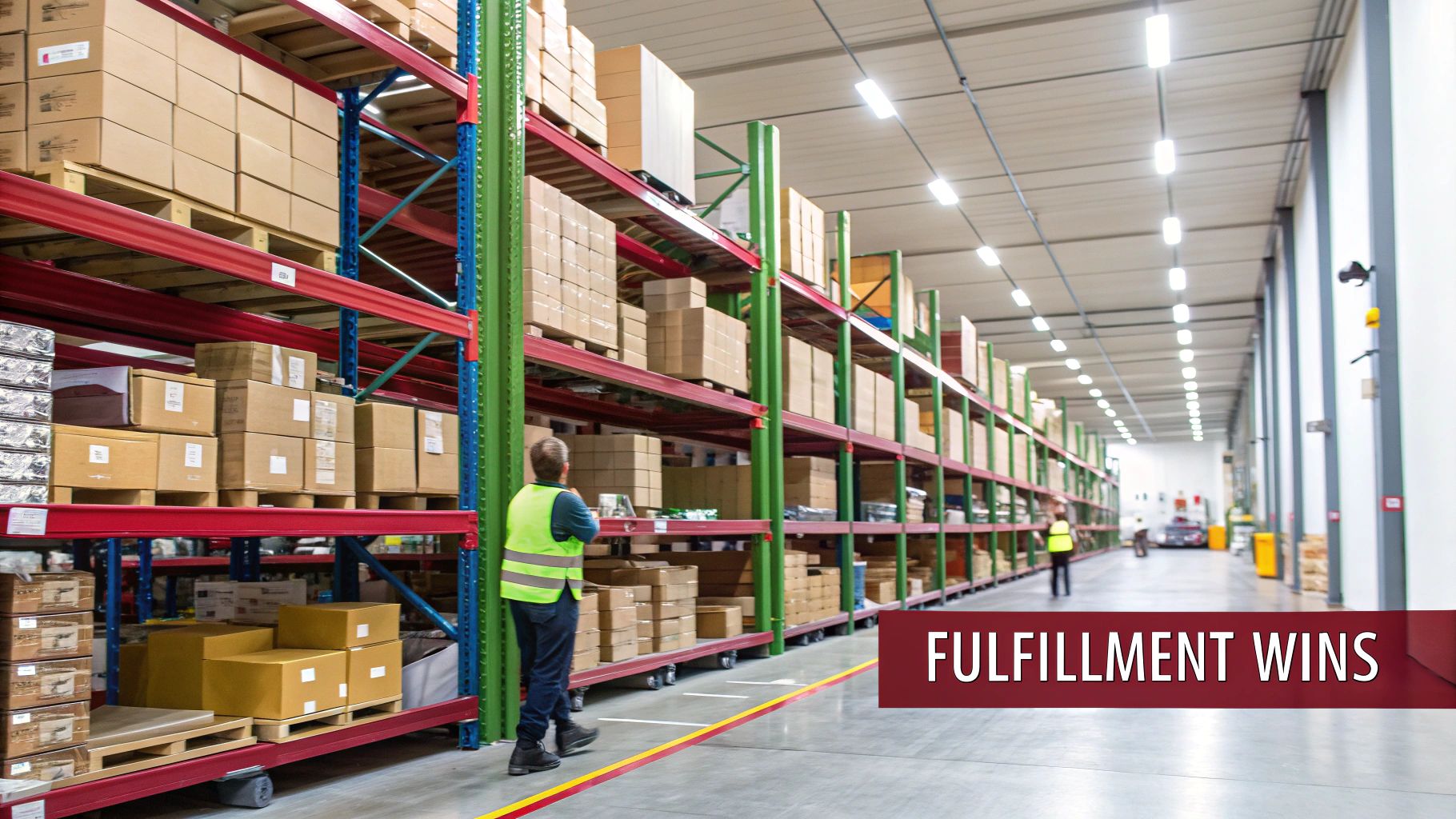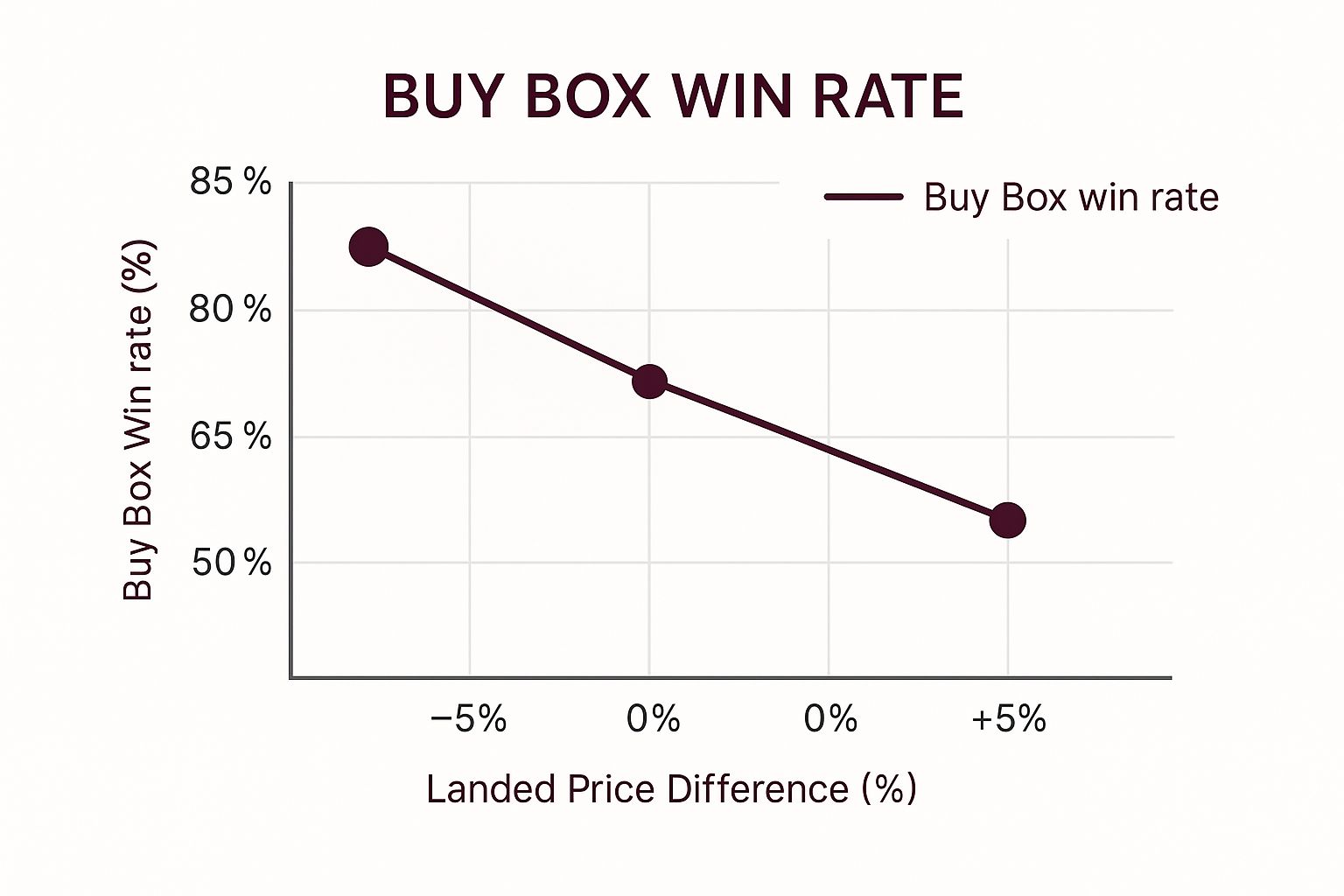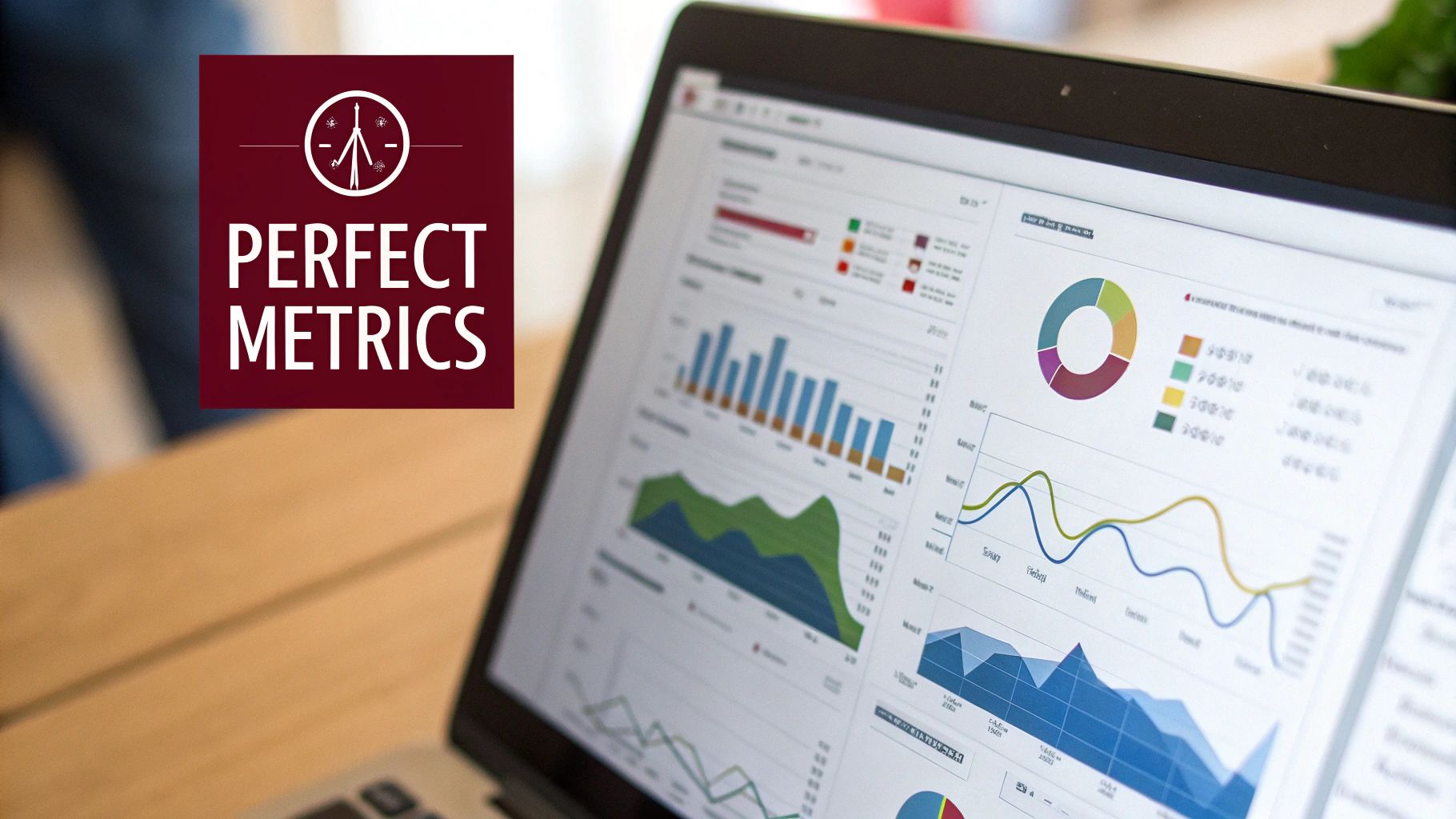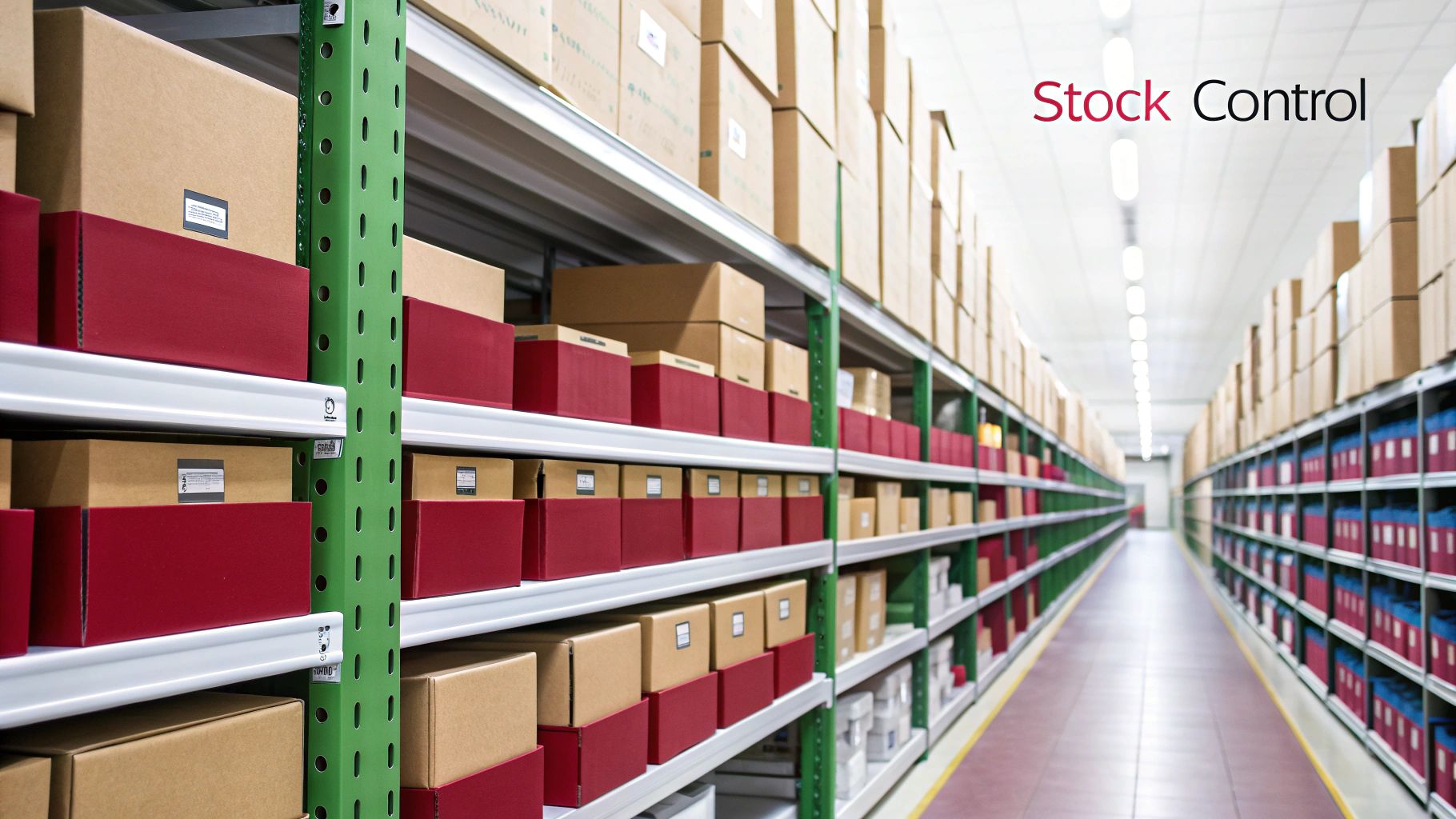To consistently win the Amazon Buy Box, you need to be the seller Amazon trusts most to keep its customers happy. A competitive price, fast fulfillment (ideally using Fulfillment by Amazon), having products in stock, and maintaining perfect seller performance metrics.
Think of it as being the most dependable, customer-friendly option on the shelf.
A huge 82% of all sales on Amazon happen through the Buy Box, and that number is even higher on mobile. If you don’t own it, you’re practically invisible. To get a better handle on this, it helps to zoom out and work on understanding digital marketplaces and how they function.
The Most Important Factors
While Amazon’s algorithm considers dozens of variables, your energy is best spent on the big four. These are the factors that carry the most weight.
- Fulfillment Method: Using Fulfillment by Amazon (FBA) is a massive advantage. Amazon inherently trusts its own logistics network to deliver products quickly and reliably, so FBA sellers get a huge leg up.
- Landed Price: This isn’t just your item price; it’s the total cost to the customer, including shipping. You don’t always need to be the absolute cheapest, but you must be competitive. A top-performing FBA seller can often win the Buy Box even with a slightly higher price than a merchant-fulfilled seller with weaker metrics.
- Shipping Speed: How fast can the product get into the customer’s hands? If you’re not using FBA, offering two-day shipping is practically a requirement to even stay in the running.
- Seller Performance: Your account health is non-negotiable. This is where your Order Defect Rate (ODR), Late Shipment Rate, and customer feedback score come into play. A squeaky-clean record signals to Amazon that you’re a trustworthy partner.
Choosing a Fulfillment Method That Wins

When you’re fighting for the Buy Box, how your product gets to the customer is more than just a logistical detail. It’s a massive piece of the puzzle. The Amazon algorithm is built on trust, and it overwhelmingly trusts its own fulfillment network to deliver a fast and reliable experience.
That’s why sellers using Fulfillment by Amazon (FBA) have such a big advantage. When you let Amazon handle your storage, picking, packing, and shipping, you’re getting an automatic seal of approval. The Prime badge that comes with FBA is a powerful signal to both customers and the algorithm that your delivery promises are solid.
FBA vs. Seller-Fulfilled Prime
For most sellers, FBA is the clearest path to improving your Buy Box chances. Amazon’s system knows an FBA order will ship on time, have valid tracking, and arrive quickly. It takes your personal shipping performance out of the equation, which removes a huge variable.
But then there’s Seller-Fulfilled Prime (SFP). This program lets you add the Prime badge to your listings while shipping from your own warehouse. It sounds great, but be warned: the performance standards are unbelievably strict. You have to commit to nationwide two-day delivery at your own cost and maintain nearly perfect shipping metrics.
If you already have a highly efficient logistics machine, SFP can be a fantastic option. For everyone else, it’s a fast track to getting your account suspended if you can’t keep up.
Competing with Fulfillment by Merchant (FBM)
What if you’re set on fulfilling orders yourself through the standard Fulfillment by Merchant (FBM) program? You can still win the Buy Box, but the bar is set much higher. You don’t get the automatic trust that FBA sellers enjoy, so you have to earn it with every single order you ship.
To have a fighting chance as an FBM seller, you essentially have to mimic FBA-level performance. That means:
- Offer Free Shipping: This is pretty much required in today’s market. Customers expect it, and the algorithm rewards it.
- Promise Fast Delivery: Your standard shipping option needs to be four days or less. If you can profitably offer two-day shipping, even better.
- Maintain Flawless Metrics: Your Late Shipment Rate, Pre-fulfillment Cancel Rate, and Valid Tracking Rate need to be as close to perfect as possible. Any slip-up will count against you.
Ultimately, the choice between FBA and FBM touches everything from your fees to your day-to-day operations. To get a deeper look at which path is right for your business, check out our detailed comparison of Amazon FBA vs FBM.
Reader Takeaway: Your fulfillment method is a direct signal of reliability to Amazon’s algorithm. Using FBA is the simplest way to send a strong positive signal. If you go the FBM route, you have to operate at an FBA-like level of speed and perfection to compete for the Buy Box effectively.
Executing a Smart Pricing Strategy
There’s a myth that you need the absolute rock-bottom price to win the Amazon Buy Box. Chasing the lowest price is a fast way to kill your profit margins. Amazon’s algorithm is smarter than that. It looks at the landed price, which is your item’s cost plus whatever the customer pays for shipping.
The real game is pricing competitively without getting sucked into a race to the bottom.
I’ve seen it time and time again: an FBA seller with stellar metrics can price their product a bit higher than an FBM competitor and still own the Buy Box. Why? Because Amazon’s algorithm trusts the fast, reliable shipping that comes with FBA and weighs that heavily, often more than a slightly cheaper but slower alternative.
Using Repricers without Destroying Profits
Automated repricing tools can be a huge help or a huge liability. A classic mistake is letting a repricer run wild without setting any guardrails. That’s how you wake up to find you’ve sold a $30 item for $12 just to undercut a competitor by a penny.
To use these tools the right way, you must set firm floor and ceiling prices.
- Set a Floor Price: This is your line in the sand. It’s the absolute minimum you’ll sell for after factoring in every single cost. You have to know all the Amazon fees for sellers to get this right. Your floor price is what protects your bottom line.
- Set a Ceiling Price: This is the highest price you believe the market can sustain. It stops your repricer from jacking the price up to something absurd if your competitors sell out, which can scare away buyers or even get your listing suppressed by Amazon.
This chart shows how your landed price stacks up against the competition and its effect on your Buy Box win rate.

As you can see, being cheaper helps. But you can still snag the Buy Box a surprising amount of the time even when your price is higher, provided your other metrics are rock-solid.
Strategic Pricing in Action
With over 80% of all Amazon purchases happening through the Buy Box, a smart pricing strategy is essential for the 9.7 million sellers worldwide.
The algorithm is constantly juggling your landed price against your fulfillment method, stock levels, and customer service scores. Pricing is just one piece of a much bigger puzzle. For a deeper dive into how all these moving parts work together, you can read the full analysis on SellerLabs.com.
Reader Takeaway: Stop obsessing over being the cheapest. Your goal should be to have the best overall offer. Use repricing tools, but lock them down with strict limits to stay competitive without giving away your profits. A slightly higher price paired with FBA and perfect seller metrics will beat a lower price with slow, unreliable shipping almost every time.
Keeping Your Seller Performance Metrics Perfect

While pricing and fulfillment are huge pieces of the Buy Box puzzle, your seller performance metrics are the foundation of your entire strategy. Think of it this way: Amazon’s algorithm is built on trust, and your account health dashboard is your report card. Falling short here isn’t just a minor slip; it’s a direct path to getting booted from the Buy Box.
These aren’t just arbitrary numbers. Every metric tells Amazon a story about how you run your business and, more importantly, how you treat their customers. The algorithm is listening to that story very closely.
The Metrics That Truly Matter
Look, some metrics carry way more weight than others. If you’re serious about winning the Buy Box consistently, you need to become obsessed with keeping these specific numbers as close to perfect as possible.
Your Order Defect Rate (ODR) is at the top of that list. This is Amazon’s main way of measuring customer experience. It’s a combination of three things:
- A-to-z Guarantee Claims: Filed by customers when an order goes seriously wrong.
- Negative Feedback: Any one or two-star review a customer leaves about their experience with you.
- Credit Card Chargebacks: When a customer disputes a charge directly with their bank.
The magic number here? You absolutely must keep your ODR below 1%. Anything higher is a massive red flag for Amazon and will get you yanked from the Buy Box rotation fast. The impact is real; I’ve seen sellers whose ODR crept above just 0.75% lose 20% to 40% of their Buy Box share almost overnight.
Shipping Performance You Can’t Ignore
Right alongside your ODR, your shipping performance is under a microscope, especially if you’re a Fulfilled by Merchant (FBM) seller. Amazon has set some crystal-clear benchmarks here, and there’s almost no wiggle room. Letting these slide can cause a domino effect of problems, so it’s smart to know the warning signs of a potential Amazon account suspension and how to steer clear.
These three shipping metrics are non-negotiable:
- Late Shipment Rate (LSR): This tracks orders shipped after the promised date. You have to keep this under 4%.
- Pre-fulfillment Cancel Rate (PCR): This is the percentage of orders you cancel before you ship them. Stay below 2.5%.
- Valid Tracking Rate (VTR): This measures if you’re providing valid tracking numbers. It needs to stay above 95%.
A simple pro-tip for keeping your VTR in the green is to use Amazon Buy Shipping or work with carriers that are fully integrated with Amazon’s platform. It ensures all your tracking info is passed along automatically and accurately.
Your seller metrics are what Amazon uses to decide if you’re a trustworthy partner. The table below breaks down the key performance indicators, the targets you must hit, and what happens to your Buy Box eligibility if you don’t.
Key Seller Metrics and Their Buy Box Impact
| Metric | Amazon Target | Potential Buy Box Impact if Target is Missed |
|---|---|---|
| Order Defect Rate (ODR) | < 1% | Severe. Can lead to immediate loss of Buy Box eligibility and potential account suspension. |
| Late Shipment Rate (LSR) | < 4% | High. Significantly reduces your Buy Box share, especially for FBM sellers. |
| Pre-fulfillment Cancel Rate (PCR) | < 2.5% | Moderate to High. Shows unreliability and negatively impacts your Buy Box chances. |
| Valid Tracking Rate (VTR) | > 95% | Moderate. Erodes customer trust and can lead to category-specific Buy Box suppression. |
These aren’t just guidelines; they are hard rules the algorithm follows. Staying within these targets is the bare minimum for competing for the Buy Box.
Key Takeaway: Your account health is a direct investment in your Buy Box eligibility. Stop looking at your performance dashboard weekly and check it daily. Treat the target percentages for ODR, LSR, and VTR as absolute limits you can never cross.
Keep Your Products in Stock—Always

Here’s a hard truth many sellers learn the tough way: you can’t win the Buy Box if you have nothing to sell.
Going out of stock is one of the quickest ways to become ineligible. It doesn’t just cost you a few sales while you wait for a restock, either. The damage is deeper than that.
When your listing goes dark, you lose all sales momentum. The A10 algorithm essentially puts you on the back burner. Even after your inventory is back, you’ll find yourself fighting an uphill battle to get back into the Buy Box rotation. This makes consistent inventory management a critical part of any serious Buy Box strategy.
Forecasting to Avoid Stockouts
The goal is to find that sweet spot between having too much inventory and not nearly enough. Overstocking will have you bleeding cash on long-term storage fees, which destroys your profit margins. Stockouts, on the other hand, kill your sales velocity and tank your organic ranking.
This is where demand forecasting becomes essential.
To do this right, you have to get a handle on your sales velocity, which is just how many units you sell per day. You can track this with a spreadsheet or use one of the many inventory management tools that connect to your Seller Central account.
Here’s a simple, practical way to approach it:
- Find Your Sales Velocity: Don’t just look at the last 30 days. Pull your sales data for the last 30, 60, and 90 days to get a solid average of daily sales. This smooths out any random spikes or dips.
- Know Your Lead Times: How long does it really take from the moment you place an order with your supplier to the moment those units are checked in at an Amazon warehouse? You need to account for production time, freight shipping, and FBA receiving times.
- Calculate a Reorder Point: This is simply the inventory level that tells you it’s time to order more. For instance, if you sell 10 units a day and your total lead time is 30 days, you need to place a new order when you have at least 300 units left in stock.
Use Amazon’s Fulfillment Network to Your Advantage
Here’s a more advanced tactic that can give you a serious edge: distributing your inventory across multiple Amazon fulfillment centers. While you can’t pick and choose warehouses, you can enable specific inventory placement settings within FBA to encourage this.
When your products are stored closer to customers all over the country, Amazon can add that “Arrives Tomorrow” badge to your listing for more shoppers. Faster delivery times are a massive positive signal to the Buy Box algorithm. It proves to Amazon that you’re positioned to deliver a top-tier customer experience, no matter where the order is coming from.
Think of it like building trust with the algorithm. Every day you’re in stock, you’re signaling reliability. You’re proving you’re a dependable seller, and that directly contributes to a higher Buy Box percentage over the long haul.
Your Action Plan to Win More Buy Box Share
Let’s turn theory into action. This isn’t about some huge, months-long project. It’s about making smart, targeted moves right now that will start tilting the Buy Box in your favor. Think of this as your immediate priority list.
First, pull up your Account Health dashboard in Seller Central. Don’t guess. Find your single weakest metric right now. Is your Late Shipment Rate creeping up? Did a negative feedback just ding your score? Whatever it is, that’s your number one target.
Next, zoom in on one of your most important ASINs. Take a hard look at the top three competitors who are consistently winning the Buy Box. Jot down their landed price and their fulfillment method. If you’re using FBM for that product, it’s time to run the numbers on switching just that one item to FBA. You might be surprised how often it makes financial sense.
Finally, check the inventory levels for your top five bestsellers. Don’t just eyeball it. Set a clear, data-informed reorder point for each one to make sure you never go out of stock. If you’re looking for another lever to pull, getting your ads dialed in can make a big difference. Our guide to Amazon ads management can give you an indirect boost by driving more traffic and sales velocity.
Getting a handle on the Buy Box algorithm is a key part of any solid list of strategies to increase online sales on Amazon.
Your Top Buy Box Questions Answered
When it comes to the Buy Box, there’s a lot of confusion. Sellers are always asking about how this really works. Let’s tackle some of the most common questions I hear.
Can I Win the Buy Box Without Having the Lowest Price?
Yes, you absolutely can. I see it happen all the time. While a low price is a big piece of the puzzle, Amazon’s algorithm is ultimately looking for the best overall value for the customer. It’s weighing other variables just as heavily, like your fulfillment method, shipping speed, and seller metrics.
Think of it this way: a seller using FBA with a near-perfect Order Defect Rate can often win the Buy Box even if their price is a few percentage points higher than an FBM competitor with slower shipping. Amazon puts a massive amount of trust in its own logistics network, and that gives FBA sellers a powerful advantage.
How Long Does It Take to Get Buy Box Eligible?
There’s no magic number here. Eligibility is something you earn, not something you’re given after a set time. For new sellers on a Professional account, the whole game is about building a solid, consistent track record of successful orders while keeping your account health perfect.
You have to prove to Amazon that you can ship on time and keep customers happy, order after order. Most sellers I’ve talked to find they become eligible after a few months of solid performance, but this can vary based on your product category and how fierce the competition is.
My advice: Think of it like building a credit score with Amazon. The more positive history you rack up, the more the algorithm will trust you with the Buy Box. It’s all about rewarding consistency.
Does Running Ads Help Me Win the Buy Box?
This is a common point of confusion, so let’s clear it up. Running PPC ads does not directly impact the Buy Box algorithm. It’s actually the other way around. You have to win the Buy Box organically for your Sponsored Product ad to even show up on the product detail page.
However, advertising can have a powerful indirect effect. A well-run PPC campaign drives more sales, which boosts your sales velocity and strengthens your sales history for that product. A strong sales history is a huge positive signal to Amazon’s algorithm, which can help you win the Buy Box more often over time.
What’s This “Buy Box Rotation” I Keep Hearing About?
On listings where there are multiple, highly qualified sellers, Amazon will often share the love by rotating the Buy Box. If you’ve got several sellers with competitive pricing, all using FBA, and all maintaining great metrics, the algorithm will split the Buy Box ownership between them.
The seller with the best overall “score” will get the biggest slice of the pie, but other qualified sellers will still get a percentage of the views and potential sales. This is why you might see the seller in the Buy Box change multiple times throughout the day on a popular item. It’s Amazon’s way of keeping the marketplace competitive and fair for its top sellers.





